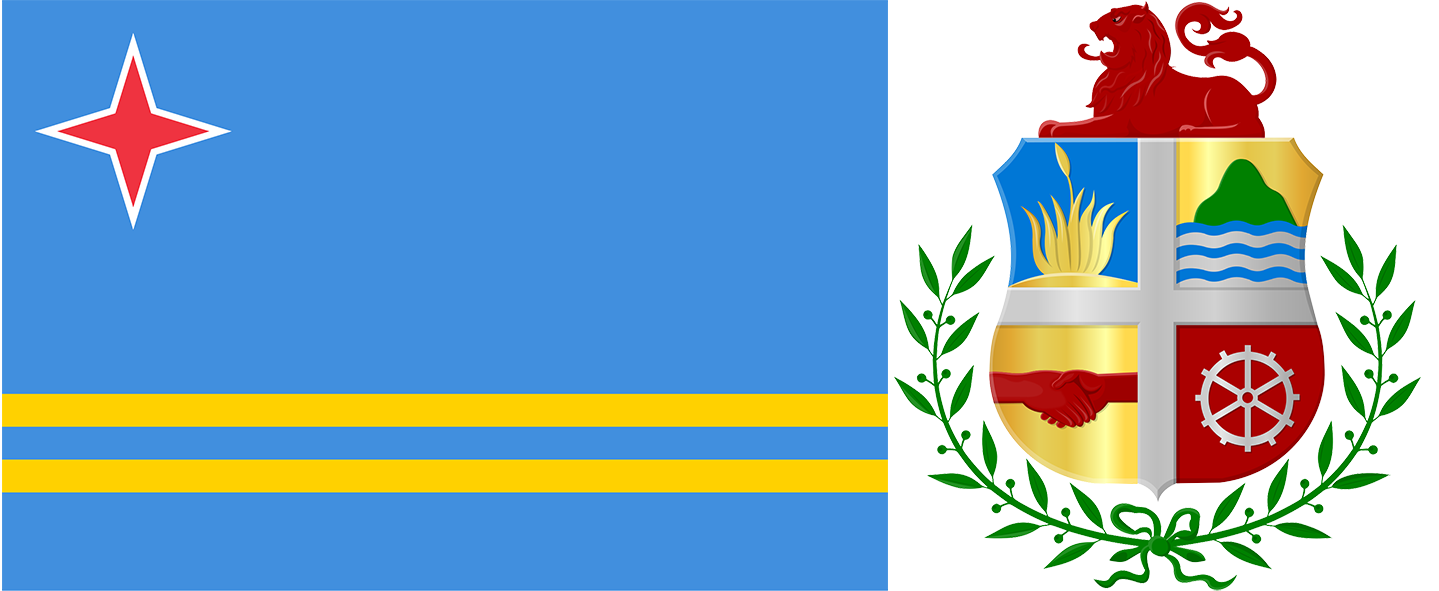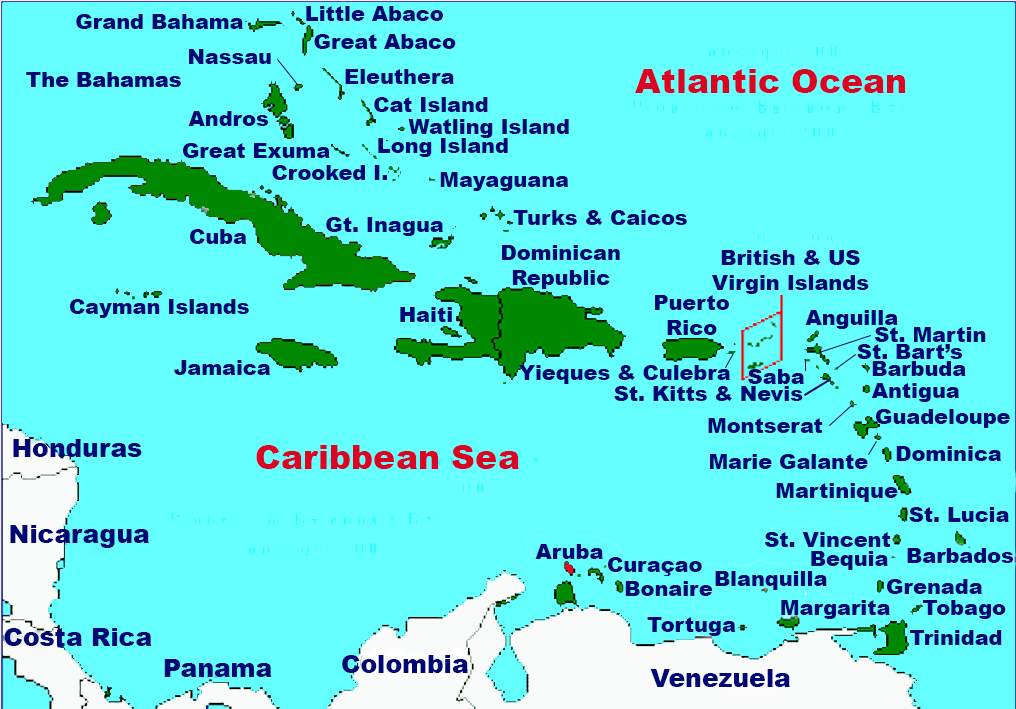FabulousFusionFood's Aruban Recipes Home Page
 The flag of Aruba (left) and the coat of arms of Aruba (right).
The flag of Aruba (left) and the coat of arms of Aruba (right).
Welcome to the summary page for FabulousFusionFood's Aruban recipes, part of the Caribbean. This page provides links to all the Aruban recipes presented on this site, with 71 recipes in total.
This is a continuation of an entire series of pages that will, I hope, allow my visitors to better navigate this site. As well as displaying recipes by name, country and region of origin I am now planning a whole series of pages where recipes can be located by meal type and main ingredient. This page gives a listing of all the Indian recipes added to this site.
Aruba, the Country of Aruba (Dutch: Land Aruba; Papiamento: Pais Aruba), is a constituent country within the Kingdom of the Netherlands, situated in the southern Caribbean Sea. Aruba lacks administrative subdivisions but is divided into eight regions for census purposes with Oranjestad as its capital.
Aruban cuisine is a multi-cultural blend of Arawak, Spanish, African and Dutch influences.
Aruba, officially the Country of Aruba (Dutch: Land Aruba; Papiamento: Pais Aruba), is a constituent country within the Kingdom of the Netherlands, situated in the southern Caribbean Sea. Aruba is located approximately 29 kilometres (18 mi) north of the Venezuelan peninsula of Paraguaná and 80 kilometres (50 mi) northwest of Curaçao.
 Location of Aruba in the Caribbean with the land mass of the
Location of Aruba in the Caribbean with the land mass of the
Aruba picked out in red.Aruba measures 32 kilometres (20 mi) in length from its northwestern to its southeastern end and is 10 kilometres (6 mi) across at its widest point. Alongside Bonaire and Curaçao, Aruba forms a group referred to as the ABC islands. The Dutch Caribbean encompasses the ABC islands, along with the other three Dutch substantial islands in the Caribbean, the SSS islands. Aruba is home to about one-third of the population of the Dutch Caribbean.
In 1986, it became a constituent country within the Kingdom of the Netherlands, and acquired the formal name the Country of Aruba. As one of the four countries in the Kingdom of the Netherlands, alongside the Netherlands, Curaçao, and Sint Maarten, Aruba shares Dutch nationality with its citizens. Aruba lacks administrative subdivisions but is divided into eight regions for census purposes with Oranjestad as its capital.
In contrast to much of the Caribbean, which experiences humid tropical climates, Aruba has a dry climate with an arid xeric landscape. The relatively warm and sunny weather persists throughout the year. Aruba has an area of 179 km2 (69.1 sq mi) and a dense population of 108,166 as per the 2020 census.
The name Aruba most likely came from the Caquetío Oruba which means 'Well situated island', seeing as it was the Caquetío who were present on the island when it was first set foot upon by Alonso de Ojeda. Between 1529 and the signing of the Treaty of Westphalia (1648), the name 'Isla de Oruba' was used for the island by the Spanish. After the signing, the island was ceded to the Dutch and gradually its name changed to Aruba.
There were many different names for Aruba used by other Amerindian groups, all of which could have contributed to the present-day name Aruba. Another Caquetío name for the island was Oibubia which means 'Guided island'. The Taino name for the island was Arubeira. The Kalinago also had two names for the island Ora Oubao which means 'Shell island' and Oirubae which means 'Companion of Curaçao'.
The original inhabitants, known as the Arawak speaking Caquetios, sustained themselves through simple farming, fishing, and hunting. They cultivated corn and brown beans together, because beans helped maintain the soil's fertility. They also grew sweet potatoes, groundnuts, cocoa, and cassava. Their sources of protein included turkey, duck, iguanas, and seafood from the nearby waters. Fruits were readily available.
Upon the arrival of the Spaniards in the Caribbean islands, they recognized the value of crops like corn, cocoa, groundnuts, and peppers. They were introduced to new fruits like papaya, avocado, coconut, guava, and pineapple. Herbs like basil and oregano, used by the indigenous people for flavoring, also caught their attention. The Spaniards learned about annatto (a saffron substitute), allspice, and other seasonings. This blend of indigenous and Spanish influences laid the foundation for the diverse Antillean cuisine
This is a continuation of an entire series of pages that will, I hope, allow my visitors to better navigate this site. As well as displaying recipes by name, country and region of origin I am now planning a whole series of pages where recipes can be located by meal type and main ingredient. This page gives a listing of all the Indian recipes added to this site.
Aruba, the Country of Aruba (Dutch: Land Aruba; Papiamento: Pais Aruba), is a constituent country within the Kingdom of the Netherlands, situated in the southern Caribbean Sea. Aruba lacks administrative subdivisions but is divided into eight regions for census purposes with Oranjestad as its capital.
Aruban cuisine is a multi-cultural blend of Arawak, Spanish, African and Dutch influences.
Aruba, officially the Country of Aruba (Dutch: Land Aruba; Papiamento: Pais Aruba), is a constituent country within the Kingdom of the Netherlands, situated in the southern Caribbean Sea. Aruba is located approximately 29 kilometres (18 mi) north of the Venezuelan peninsula of Paraguaná and 80 kilometres (50 mi) northwest of Curaçao.
 Location of Aruba in the Caribbean with the land mass of the
Location of Aruba in the Caribbean with the land mass of theAruba picked out in red.
In 1986, it became a constituent country within the Kingdom of the Netherlands, and acquired the formal name the Country of Aruba. As one of the four countries in the Kingdom of the Netherlands, alongside the Netherlands, Curaçao, and Sint Maarten, Aruba shares Dutch nationality with its citizens. Aruba lacks administrative subdivisions but is divided into eight regions for census purposes with Oranjestad as its capital.
In contrast to much of the Caribbean, which experiences humid tropical climates, Aruba has a dry climate with an arid xeric landscape. The relatively warm and sunny weather persists throughout the year. Aruba has an area of 179 km2 (69.1 sq mi) and a dense population of 108,166 as per the 2020 census.
The name Aruba most likely came from the Caquetío Oruba which means 'Well situated island', seeing as it was the Caquetío who were present on the island when it was first set foot upon by Alonso de Ojeda. Between 1529 and the signing of the Treaty of Westphalia (1648), the name 'Isla de Oruba' was used for the island by the Spanish. After the signing, the island was ceded to the Dutch and gradually its name changed to Aruba.
There were many different names for Aruba used by other Amerindian groups, all of which could have contributed to the present-day name Aruba. Another Caquetío name for the island was Oibubia which means 'Guided island'. The Taino name for the island was Arubeira. The Kalinago also had two names for the island Ora Oubao which means 'Shell island' and Oirubae which means 'Companion of Curaçao'.
Food and Cuisine:
Antillean cuisine shares similarities with dishes from other Caribbean islands and Venezuela, but it also possesses its own distinct character. Over the course of history, these islands changed ownership multiple times and were inhabited by diverse races, each contributing to the development of the culture, language, music, and food.The original inhabitants, known as the Arawak speaking Caquetios, sustained themselves through simple farming, fishing, and hunting. They cultivated corn and brown beans together, because beans helped maintain the soil's fertility. They also grew sweet potatoes, groundnuts, cocoa, and cassava. Their sources of protein included turkey, duck, iguanas, and seafood from the nearby waters. Fruits were readily available.
Upon the arrival of the Spaniards in the Caribbean islands, they recognized the value of crops like corn, cocoa, groundnuts, and peppers. They were introduced to new fruits like papaya, avocado, coconut, guava, and pineapple. Herbs like basil and oregano, used by the indigenous people for flavoring, also caught their attention. The Spaniards learned about annatto (a saffron substitute), allspice, and other seasonings. This blend of indigenous and Spanish influences laid the foundation for the diverse Antillean cuisine
The alphabetical list of all the Aruban recipes on this site follows, (limited to 100 recipes per page). There are 71 recipes in total:
Page 1 of 1
| Arepa di Pampuna (Pumpkin Pancakes) Origin: Aruba | Christmas Roast Ham Origin: Aruba | Pastechi Karni (Aruban Meat Empanadas) Origin: Aruba |
| Aruba Chicken Origin: Aruba | Citrus Chicken Origin: Aruba | Pisca den Foil (Foil-cooked Fish) Origin: Aruba |
| Aruba Curry Powder Origin: Aruba | Cocoda (Aruban Coconut Candy) Origin: Aruba | Pisca Hasa (Fried Fish) Origin: Aruba |
| Aruba Green Seasoning Origin: Aruba | Coconut Shrimp Origin: Aruba | Pudding di Mashi (Corn Pudding) Origin: Aruba |
| Aruba Mango Chutney Origin: Aruba | Conch Curry Coconut Banana Chowder Origin: Aruba | Rum Balls Origin: Aruba |
| Aruba Sambal Tomat (Tomato Sambal) Origin: Aruba | Creole Calamari Origin: Aruba | Salada di Batata (Potato Salad) Origin: Aruba |
| Aruban Corn Bread Origin: Aruba | Dry Curried Chicken Origin: Aruba | Saltfish Buljol with Avocado and Cucumber Origin: Aruba |
| Aruban Curried Chicken Origin: Aruba | Forgotten Pudding Origin: Aruba | Sambal Tomat (Tomato Sambal) Origin: Aruba |
| Aruban Curried Goat Origin: Aruba | Fresh Coconut Cake Origin: Aruba | Sancochi di Galinja (Chicken Stew) Origin: Aruba |
| Aruban Curried Mutton Origin: Aruba | Funchi Origin: Aruba | Sanger Yena (Offal Sausages) Origin: Aruba |
| Aruban Curry Chicken Origin: Aruba | Ham di Pasku (Easter or Holiday Ham) Origin: Aruba | Saté (Marinated Kebabs) Origin: Aruba |
| Aruban Curry Goat Origin: Aruba | Kabritu Stoba (Stewed Kid Goat) Origin: Aruba | Seafood Pastechi Origin: Aruba |
| Aruban Iced Coconut Soup Origin: Aruba | Karko Stobá (Queen Conch Stew) Origin: Aruba | Seasoned Red Pepper Paste Origin: Aruba |
| Bakiou Stobá (Salt Cod Stew) Origin: Aruba | Keshi Yena (Filled Cheese Shells) Origin: Aruba | Sopa di Bonchi Korá (Red Kidney Bean Soup) Origin: Aruba |
| Banana den Forno (Baked Bananas) Origin: Aruba | Koeki di Pinda y Chuculati (Peanut and Chocolate Chip Cookies) Origin: Aruba | Sopi di Pampuna (Pumpkin Soup) Origin: Aruba |
| Bitterbal (Meat Croquettes) Origin: Aruba | Kokada (Aruban Coconut Candy) Origin: Aruba | Sopi di Piská (Fish Soup) Origin: Aruba |
| Bolita di Keshi (Cheese Balls) Origin: Aruba | Kokos Taart (Coconut Tart) Origin: Aruba | Sopi Mondongo (Soul-food Soup) Origin: Aruba |
| Bolitas de Jamon (Ham Balls) Origin: Aruba | Krokèchi (Prawn Croquettes) Origin: Aruba | Spiced Yucca Chips Origin: Aruba |
| Bolo Polana (Cashew Nut Cake) Origin: Aruba | Mankaron (Antillean Macaron) Origin: Aruba | Stroopwafels Origin: Aruba |
| Bolo Preto (Aruban Black Cake) Origin: Aruba | Pan Bati Origin: Aruba | Tutu (Cornmeal Porridge with Black-eyed Peas) Origin: Aruba |
| Cala (Black-eyed Pea Puffs) Origin: Aruba | Panlevi (Sponge Biscuits) Origin: Aruba | Webo Yena (Stuffed Devilled Eggs) Origin: Aruba |
| Calco Stoba (Conch Stew) Origin: Aruba | Papaya Pudding Origin: Aruba | Yambo Origin: Aruba |
| Caldo de Pescado (Aruban Fish Soup) Origin: Aruba | Pastechi di Tonijn (Tuna Pastechi) Origin: Aruba | Zùlt (Pickled Pigs' Ears) Origin: Aruba |
| Cheese Pastechi Origin: Aruba | Pastechi Galiña (Chicken Pastechi) Origin: Aruba |
Page 1 of 1